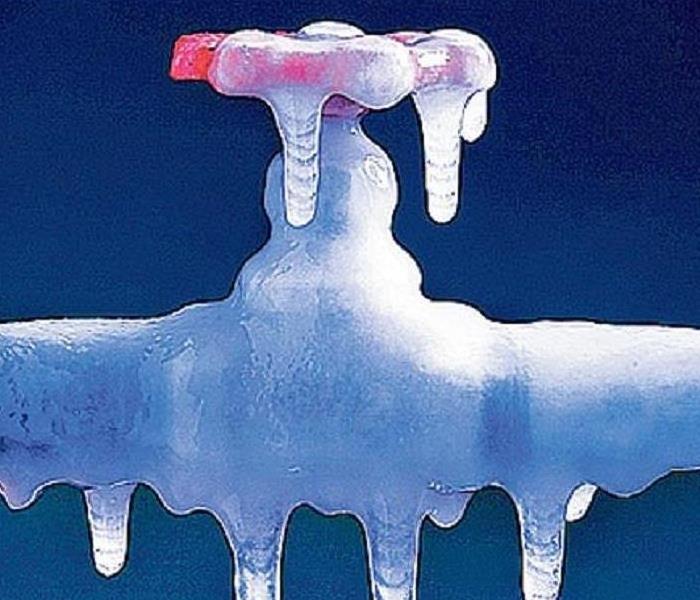Recent Storm Damage Posts
Cleaning Flood Damage in a Fayetteville Home
6/12/2022 (Permalink)
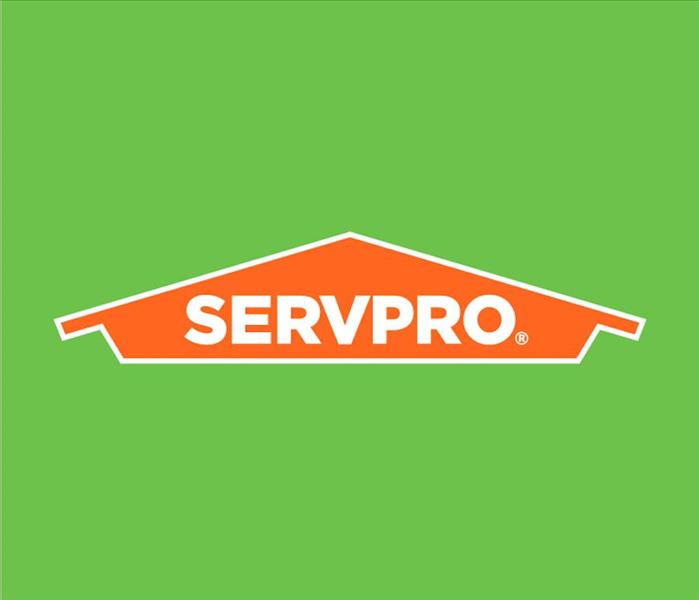 Flood damage restoration is a job for SERVPRO. Our technicians have the training and equipment for every size disaster.
Flood damage restoration is a job for SERVPRO. Our technicians have the training and equipment for every size disaster.
Flood Damage in a Fayetteville Home-call SERVPRO
Storms involve drenching rainfall which saturates grounds and fills riverbanks. If your Fayetteville home is located in a flood-prone area, you might experience damage. The waste, mud, and high water volumes cause considerable property damage. However, much can be salvaged if immediate restoration steps are taken.
Some structural flood damage in a Fayetteville home may be apparent, while others may require closer inspection. SERVPRO technicians can inspect your home for damage, such as distortion and warping of floorboards, wet wallboard, paneling, insulation, and plaster.
Areas that require thorough inspection include;
- Electrical and gas appliances
- Air conditioning and heating systems
- Flooring and carpeting
- Drywalls and ceilings
Water absorbed by porous materials may dry, but the contaminants left behind continue to pose risks. Therefore you should dispose of porous materials like mattresses, upholstered furniture, and vinyl flooring, especially if they have been underwater for more than 24hours. If the carpeting on the floor is not removed, it fosters mildew, wood decay, and warpage of wooden flooring by hindering its drying.
Important considerations after a flood
Our technicians can help salvage items and fixtures, like glass, plastic, porcelain, and concrete, through thorough cleaning, disinfecting, and drying as quickly as possible. Also, it would be best if you do not use electrical appliances that have been submerged in water, even for a short period. SERVPRO can recommend a certified electrical repair professional to service the devices.
Gas appliances damaged by floodwater must be inspected and repaired by a certified professional. Even if the device appears to be functioning properly, the safety features may have been disabled by standing water and can be dangerous to operate. Gas leaks caused by floodwater damage can cause fires if exposed to flames.
Other services offered by experts
- Washing out dirt, mud, and debris using a hose
- Cleaning surfaces that have been inundated with floodwaters
- Discarding all foods exposed to floodwater
SERVPRO of East Onondaga County is your best option for cleaning up flood damage "Like it never even happened." Call us at (315) 446-8776.
Call SERVPRO for Flood Damage Cleanup After a Storm in Syracuse
1/30/2022 (Permalink)
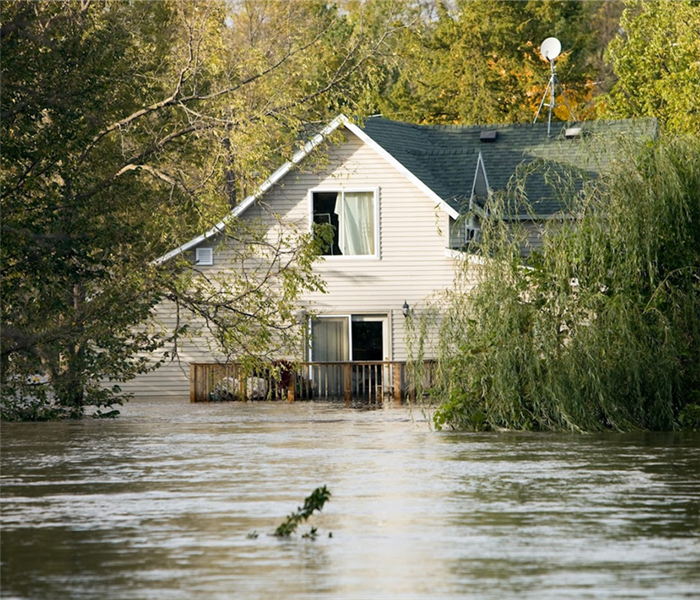 Floodwaters after a storm can quietly enter your home. Stay vigilant and contact SERVPRO for help with water removal and flood damage remediation.
Floodwaters after a storm can quietly enter your home. Stay vigilant and contact SERVPRO for help with water removal and flood damage remediation.
Need Water Removal and Damage Repairs After a Storm in Syracuse – Call SERVPRO
Storms rolling through Syracuse can cause a great deal of flood damage in a matter of minutes. Your home or business can quickly be inundated with water through broken windows or holes torn in the roof from high winds. Many residents are amazed at the amount of damage water can cause once the drywall, insulation, and flooring materials are soaked with water after a storm.
SERVPRO is available 24/7 and can be onsite in less than four hours to help residents deal with flood damage caused by storms in Syracuse. Water damage from a broken window is often limited to one area of the house. Losing a portion of your roof can let water into the house, and often the entire home will become soaked with water in a matter of minutes. Our team provides emergency board-up service and tarps to cover the damaged roof to prevent further damage.
Our SERVPRO site team leader will inspect the residence and identify the wet areas and the solutions to dry your home so it can be returned to its original condition. We remove attic, and wall insulation, perform flood cuts to dry the interior of the walls, and prevent microbial growth. Carpets often delaminate when they become soaked. We remove the carpet and underpad in these situations.
Our SERVPRO team reviews all necessary work required to dry your home with the owner and their insurance adjuster. We work closely with insurance companies and manage the invoicing with them. Our objective is to manage the demolition and restoration of your home while providing our professional services:
- Water Clean Up
- Damage Control – Board up and Roof-Tarp Covering
- Water Damage Repairs and Flood Restoration
Call SERVPRO of East Onondaga County in Syracuse and nearby areas. We can help 24/7. Call (315) 446-8776.
Frozen Pipes and Ice Damming in Syracuse – Call SERVPRO
12/29/2021 (Permalink)
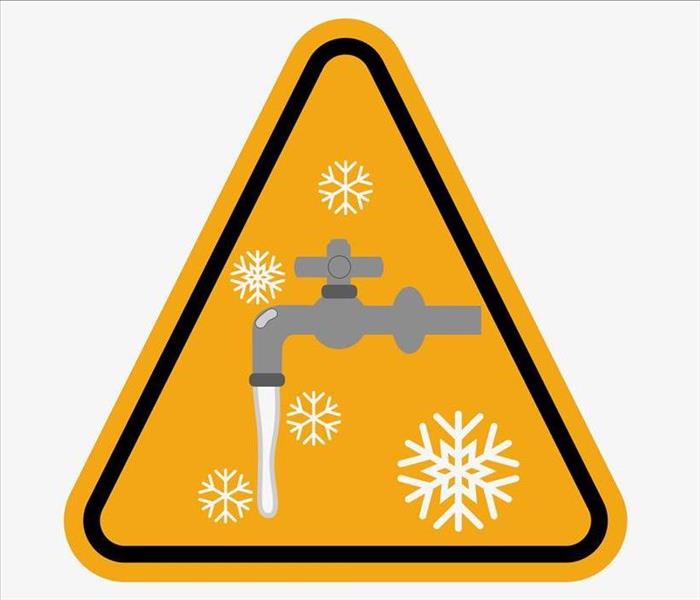 When a storm damages your home, SERVPRO is the team to call. Storm and flood damage restoration is a specialty of ours.
When a storm damages your home, SERVPRO is the team to call. Storm and flood damage restoration is a specialty of ours.
SERVPRO can help with Water Damage Caused by Frozen Pipes and Ice Damming in Syracuse
Lake effect snow, high winds, and freezing temperatures contribute to damage from thawing ice and snow in Syracuse homes every year. Fluctuating temperatures combined with lake effect snow on roofs causes the snow to melt and refreeze lower down on your roof, gradually building up an ice dam causing the melting water to pool and leak between the shingles into your home. Most homeowners will not be aware there is a problem until water begins seeping through the ceiling into the home's interior.
SERVPRO provides water damage cleanup caused by frozen pipes and ice damming to Syracuse homes. When water begins to pool on the roof, it finds a way between the shingles, pours onto the insulation, onto the ceiling, leaks through the ceiling, or flows inside wall cavities before spreading over your floor. The amount of damage can be extensive, affecting your floors, walls, ceilings, and insulation. SERVPRO can help provide water removal services and water damage repairs. Homeowners can take action to reduce the danger of damage caused by ice dams.
If your home is prone to ice damming, you may want to consider the following methods to reduce the possibility of damage:
- Close up air leaks into the attic around light fixtures, plumbing pipes, and attic access points to prevent heat loss
- Check your attic insulation and add insulation to increase the R-value to approximately 40
- Ensure roof and soffit vents are installed and clear to enhance airflow
- Add roof vents if not already in place to improve airflow.
- Remove excess snow from the roof using a snow rake.
- Replacing a roof? Install rubber membranes around skylights and at the bottom of the roof to prevent water from seeping through
Call SERVPRO of East Onondaga County in Syracuse and nearby areas. We can help 24/7. Call (315) 446-8776.
Need Help with Flood Damage Cleanup After a Storm in Syracuse – Call SERVPRO
11/26/2021 (Permalink)
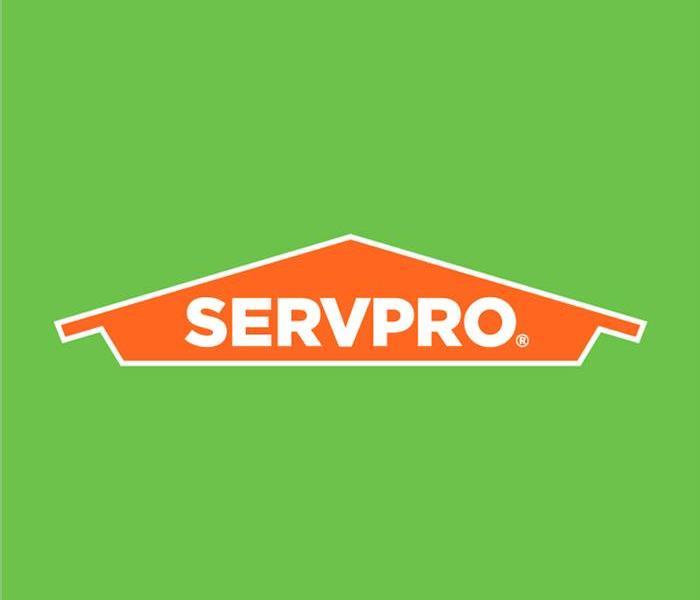 Storm and flood damage restoration is a job for SERVPRO. No matter the size of disaster, flood damage mitigation is what we do.
Storm and flood damage restoration is a job for SERVPRO. No matter the size of disaster, flood damage mitigation is what we do.
SERVPRO Provides Flood Damage Cleanup and Restoration of Your Home and Property
Trees have fallen, the power is out, and water and debris cover the inside of your Syracuse home. You are concerned about safety, is it safe to enter, and you cannot even get in the front door due to fallen branches. While this damage may not be exactly your situation after a storm, storm damage incidents can be very chaotic and difficult to manage. Homeowners need help clearing debris, protecting their homes from additional damage, and handling insurance claims with their insurance company. Finding support can be challenging.
SERVPRO provides flood damage cleanup in Syracuse. We can clear debris from the outside of your home, protect your home from further damage by boarding up broken doors and windows, and placing tarps over the roof if the roof is damaged. We also coordinate the restoration of your property and work closely with your insurance adjuster to make your life much less stressful.
A storm can introduce thousands of gallons of water into your basement, bringing with it mud and debris that may be laced with chemicals, bacteria, and viruses. Our truck-mounted water extractors can operate from our portable power sources and quickly remove excess water from the basement and other submerged areas. If the water is contaminated, we pump water directly into a treated sewer line or a septic tank company truck.
Our SERVPRO team can assist with all of the damage caused by the storm, and we coordinate building services contractors to make repairs and restore your home once it is cleaned, sanitized, and dried. Our services include:
Call SERVPRO of East Onondaga County for flood damage restoration in Syracuse and nearby areas. We can help 24/7. Call (315) 446-8776.
Who Can I Call for Emergency Services for Water Damage in Syracuse?
11/1/2021 (Permalink)
 When a storm destroys your home, don't fret. SERVPRO has the storm damage mitigation team needed for your problem.
When a storm destroys your home, don't fret. SERVPRO has the storm damage mitigation team needed for your problem.
SERVPRO Provides Flood Restoration in the Syracuse Area
During the fall season, it is quite common to see high-speed winds in parts of New York. While it may be enjoyable to watch the colorful fall leaves blow off the trees and float around, wind could cause damage to your structure. Wind can cause shingles to come loose and possibly create a hole in your roof. Wind could also cause a tree branch to break off and crash into your house.
In many cases, wind can be the cause of flood damage in your Syracuse home. For example, if the wind picks up a rock or other debris from outside, it could slam into your house and possibly break a window. Any time a hole gets punctured in your structure, more problems can be created since the interior of your home is now exposed to the outdoor elements. If it starts to rain or snow after the interior of your building gets exposed, moisture from the outdoors could get inside.
If anything inside your house ever gets wet by rainwater entering your structure, it is wise to seek help from professionals. Since water coming in from the outdoors could be contaminated, a professional company like SERVPRO can take measures to remove any contaminants. After rain gets into your house, we can assist with the following services:
- Water Damage Remediation
- Flood Restoration
- Fixing Ceiling Leaks
- Repairing a Leaking Roof from Storms
- Basement Flooding Clean Up
- Water Removal Services
If any soft, porous items in your house, such as blankets or your carpet or pad, get wet, they must be removed due to the possibility of contamination. We can then use specialized products to remove contaminants from harder surfaces.
If the wind ever causes a leak in your roof, call SERVPRO of East Onondaga County at (315) 446-8776.
Get Back Your Life Back to Normal With Storm Flood Damage Restoration in Syracuse
9/21/2021 (Permalink)
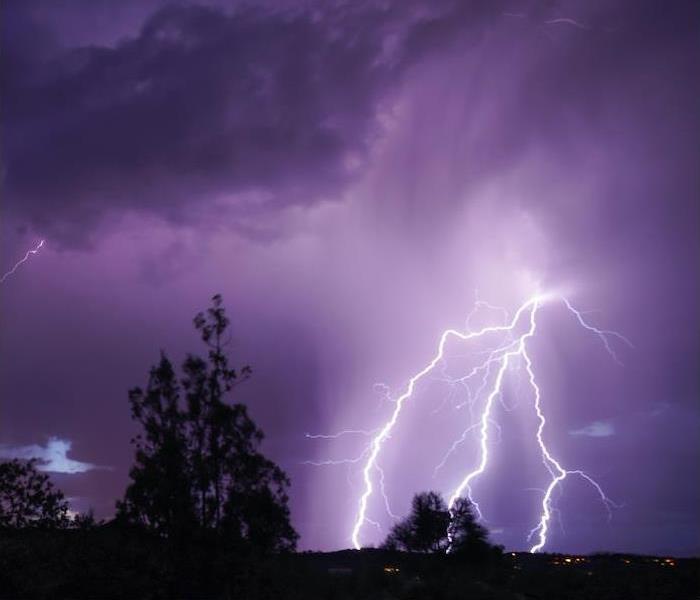 SERVPRO has the tools and equipment it takes to get your home back in order after storm damage.
SERVPRO has the tools and equipment it takes to get your home back in order after storm damage.
SERVPRO Provides Efficient Flood Damage Repair in Syracuse
If your home sustains storm damage, hiring an experienced restoration team to fix your property is invaluable. SERVPRO is a full-service restoration company, and we can take action right away to protect your assets. If the storm created some openings in your home, we could provide emergency roof tarping and board-up services to protect it.
We have the expertise and equipment required to offer storm flood damage restoration in your Syracuse residence. Our certified technicians can work fast to remove debris, standing water, and moisture before any more damage can occur. Regardless of the severity of the destruction, our team is there to assist you. Our SERVPRO restoration team:
- Responds fast to reduce damages
- Creates a customized plan that can restore your house to its preloss state
- Uses a nationwide network of support
Standing water in your home can lead to mold growth. If we discover mold in your mold, the critical course of action is to remediate and dry it as fast as possible. Our SERVPRO team can establish a scope of repair and remediation by:
- Inspecting the affected areas
- Implementing containment and engineering controls to prevent cross-contamination.
- Removing compromised contents and materials per industry standards.
- Cleaning the air thoroughly using HEPA vacuums.
- Cleaning all surfaces using cleaning solutions that might include EPA registered disinfectants.
Thorough drying is also vital after flooding. It may be necessary to dry your ceilings. In that case, our restorers can use air moving equipment to direct airflow across the wet ceilings to evaporate the moisture. When airflow is directed across the wet ceilings, the warm air which has risen to the ceiling also circulates. Ventilation is also vital for drying hard-to-dry areas such as walls. Our SERVPRO restorers are committed to excellence, meaning that you can expect effective ongoing reporting and communication from us.
Storm flood damage is unexpected, and it can be stressful for you. Call SERVPRO of East Onondaga County at (315) 446-8776 for help. We can make the flood damage seem, “Like it never even happened.”
What Are Some Unlikely Problems Caused By Flood Damage In Fayetteville Homes?
8/6/2021 (Permalink)
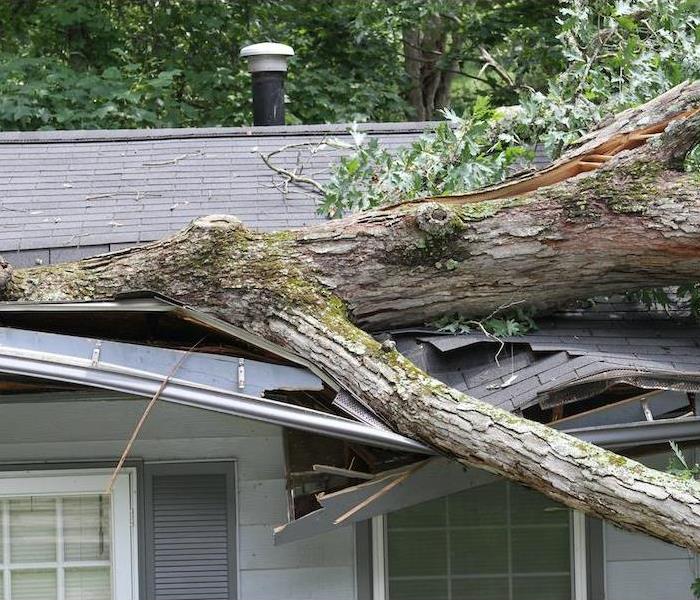 Storm and flood damage restoration is no easy task. SERVPRO uses trained and experienced techs for every job.
Storm and flood damage restoration is no easy task. SERVPRO uses trained and experienced techs for every job.
Assistance from SERVPRO Helps Ease All Water Damage Repairs at Your Home
Pools of stagnant water and deep soiling are typical outcomes after a flooding incident. However, you may experience other problems which might complicate the restoration of your Fayetteville home.
The complexities of the flood damage at your Fayetteville home may arise from how the water breaches the building. For instance, during storms, the roof might be destroyed, allowing rainwater to filter into the ceiling and wall cavities. The soaked drywall and ceiling tiles can collapse into the house, leaving a mass of debris. SERVPRO helps remove the waste and rebuild the damaged assemblies during flood restoration.
Other essential processes include:
- Sewage cleanup
- Basement flooding cleanup
- Ceiling repairs from water damages
When the internal assemblies in your house collapse, various other issues can develop, including damage to the electrical cabling. Venturing into the house in its damaged state exposes you to the risk of electric shock. Our SERVPRO technicians overcome this risk by using protective gear such as rubber boots and heavy-duty gloves.
Disposing of the various wastes left in the aftermath of flooding might be challenging. For instance, disposing of water contaminated with raw sewage and other hazardous materials into storm drains is illegal. Collecting the mixed debris from torn ceilings and other structural materials can also pose challenges. Our SERVPRO technicians use large trash cans and zip lock bags to ease the collection and classification of debris for easier disposal.
SERVPRO of East Onondaga County has sufficient resources to address any challenge posed by flood damage. Call us at (315) 446-8776. We’re Faster To Any Size Disaster.
Storms in Syracuse Can Cause Food Damage to Homes
3/22/2021 (Permalink)
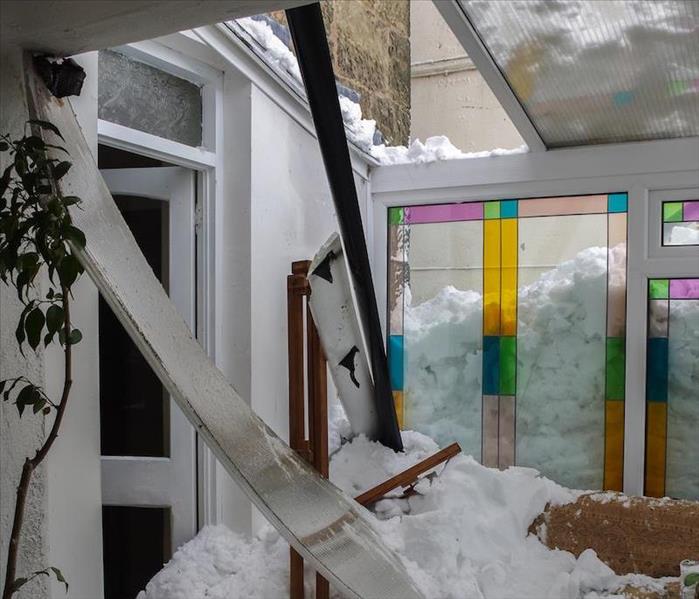 Snowstorm remediation for your home is a job for a professional team. SERVPRO is the team needed for your needs.
Snowstorm remediation for your home is a job for a professional team. SERVPRO is the team needed for your needs.
SERVPRO provides emergency services water damage services that can put your home back in order
Syracuse, NY, is a crossroad to many places and has been since its early days. It connected folks as part of the Erie Canal and then later as part of a railroad network. Today I-81 and I-90 intersect in Syracuse, and that, combined with a major airport, makes it one busy city. The area's history goes back to the 1600s when French Jesuit priests began to work with the Indians. There are lots of reasons to visit the city and take in the many sites.
East Syracuse Free Library
The libraries in NY are opening up, and many are offering browsing times by appointment. Curbside pickup is another option. You can enjoy e-books, tutoring, and plenty of new books. This is just one of the branches of the Syracuse library system.
History Highlights
Syracuse is rich in history, and you can visit many of the landmarks and historical places. Some of the historical highlights include:
• 1600s – Onondaga Nation, Jesuit priest, soldiers, and coureurs des bois start the mission Sainte Marie de Gannentaha on Onondaga Lake.
• During the Revolutionary War, most of the Iroquois tribes sided with the British. Only two tribes fought for the patriots.
• Commercial salt production took place from the 1700s to the early 1900s.
• February 4, 1820 – The town gets its name and a post office.
• Franklin Automobile Company is established. First air-cooled engine anywhere.
• 1841 – New York State Fair takes place.
Music Lover's Paradise
For those who enjoy the performing arts, and especially music, Syracuse has two outdoor festivals each year. The Jazz in the Square and the Syracuse Jazz Festival has hosted many well-known names, including:
• Smokey Robinson
• Chuck Mangione
• Aretha Franklin
• Joshua Redman
• Jimmy Sturr & Orchestra
• Kenny Goumulka
Other musical venues include the Syracuse Symphonia, the Clinton String Quartet, The Syracuse Friends of Chamber Music, and The Society for New Music. All of these offer performances throughout the year.
Enjoy a Good Meal
Restaurants are opening up as well, and many provide take-out and curbside pickup. The food options are fantastic. You can enjoy cultural dishes or down-home cooking. Here are some of the places that are serving up delicious meals:
• Apizza Regionale
• Texas de Brazil
• Café Kubal
• Eva's European Sweets
• Pastabilities
• Kitty Hoynes Irish Pub & Restaurant
• Dark Horse Tavern
All of that is just the tip of the iceberg when it comes to activities and places to eat. There are beautiful parks in the city that encourage residents to walk, jog, play basketball, and enjoy the sunshine. It is a lovely city.
SERVPRO Provides Flood Damage Removal Services to Syracuse Homes
Spring brings with it melting snow, storms, and heavy rains that can cause flash flooding. This can lead to heavily contaminated water pouring into your home. To prepare for the possibility of floods, homeowners should:
• Ensure gutters and storm drains are free of debris
• Keep valuables on upper levels if you are prone to basement flooding
• Place essential documents in waterproof containers
• Keep emergency kits on hand
If your home gets flooded, we provide water damage restoration. Flood restoration includes:
• Water extraction
• Removal of unsalvageable items
• Disinfecting and sanitizing
• Controlled Demolition
• Flood Cuts
If you need basement flooding cleanup, call the water damage restoration pros. Contact SERVPRO of East Onondaga County at (315) 446-8776 today.
Can Floods Damage a Home's Foundations?
2/24/2021 (Permalink)
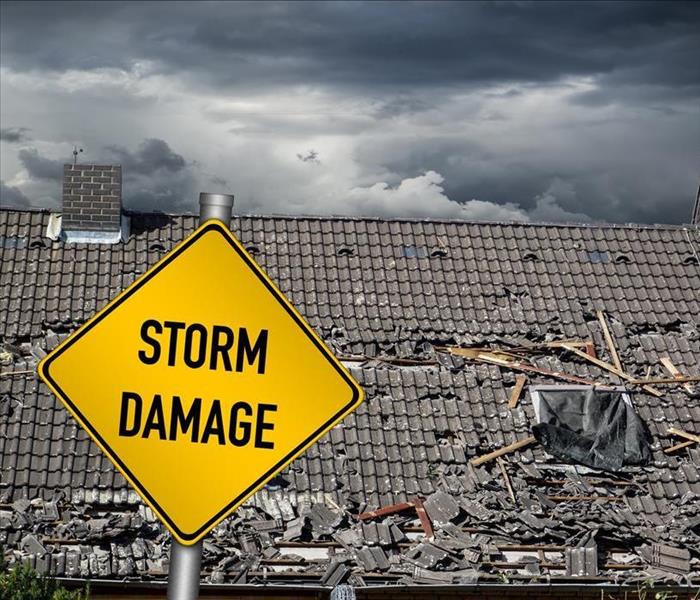 When floods occur, you need the help of a professional outfit. SERVPRO has you covered from start to finish in flood mitigation services.
When floods occur, you need the help of a professional outfit. SERVPRO has you covered from start to finish in flood mitigation services.
SERVPRO Technicians Can Protect the Integrity of your Home's Structure After Flooding
Syracuse is an important economic and educational center within the state of New York. The city is home to 145,252 residents and is part of a broader metropolitan area with a population numbering 662,577 people. As the fifth-largest city in New York State, Syracuse has a long history in both the formation of the United States and in its trade history. The Erie Canal was a vital shipping and export center for the East Coast to transport goods and raw materials into and out of America. Syracuse's town was first named and incorporated in 1820 due to the saltwater lake Onondaga, which showed resemblance to the Sicilian city of the same name. The early economy relied heavily on the salt industry, which later transformed into the steel and manufacturing industries. Twenty-first century Syracuse is well-known for its leading educational and medical economies.
Syracuse has several attractions that bring in tourism from the surrounding east coast cities. Clinton Square in the heart of the downtown district features excellent cultural curiosities of the region, including The Landmark Theater. The area is also home to the New York State Fair, one of the oldest running festivals in the US. Over 13 days, visitors are treated to over 500 performances, with daily shows taking place at the State Fair Boulevard. Syracuse's local history is lovingly recorded at the Erie Canal Museum, which covers the native tribes, earliest settlers into the area. It tracks the growth of Syracuse through the nineteenth and twentieth centuries.
- Central New York Regional Market sits on Lake Onondaga's shores with hundreds of vendors selling fresh local produce, bakery items, and sundries. The market takes place on Park St. on weekends attracting both visitors and residents.
- The NBT Bank Stadium is a Minor League Baseball ground that is the home of the Syracuse Mets. Despite being a minor-league arena, its 11,071 fans' facilities are similar to a major league ballpark with ample parking, food trucks, and corporate facilities.
- Destiny USA is a prime tourist attraction that blends luxury retail stores with dining areas and entertainment. Unlike other shopping malls, Destiny features a rotating roster of retail stores in some sections to ensure a diverse selection of goods throughout the year.
SERVPRO Can Help Secure your Syracuse Home Against Flood Damage
When floodwaters enter a property, they can exert a significant pound-for-pound pressure against wall joints, floors, and ceilings. Our technicians can conduct a detailed scoping of the property to ensure that waterlogging, electrical hazards, or damaged fittings do not lead to a structural collapse. By mitigating these losses urgently, we can help prevent permanent damages occurring in your home.
- Technicians can examine inner joints and outer ground movement on your property to assess the likelihood of structural collapse.
- Waterlogging can make subfloors and ceilings weak. Using water extractors, we can quickly remove excess pressure on the structure of your home.
- Our technicians can provide temporary power or restore power to your home following a flood-related power outage.
Floods can cause excessive damage without proper mitigation. Contact SERVPRO of East Onondaga County for flood damage at (315) 277-6476.
Protecting Syracuse's Art and Culture from Flood Damage
1/25/2021 (Permalink)
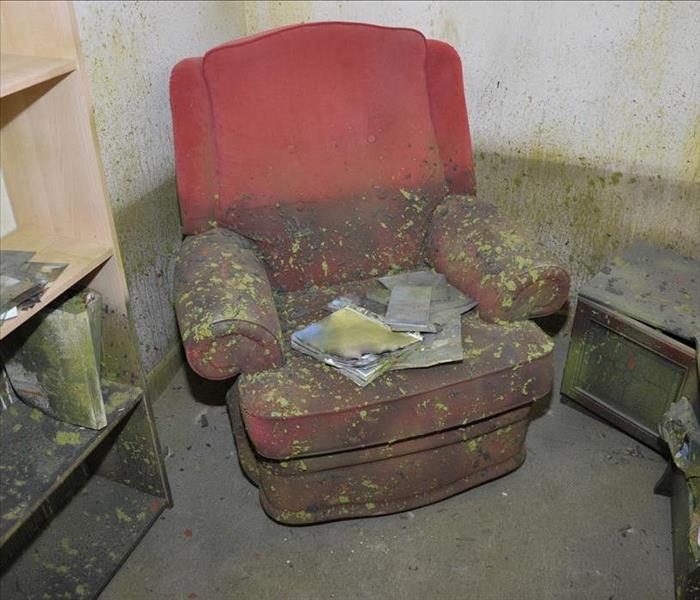 When a storm comes through and floods follow, you need the help of professionals. Call SERVPRO and their trained technicians.
When a storm comes through and floods follow, you need the help of professionals. Call SERVPRO and their trained technicians.
Rising waters can destroy unique artwork and exhibits when mitigation does not begin quickly.
As a college town, Syracuse has a lot to offer for people of all ages. It is the fifth most populated city in New York, making it a popular destination for travelers who might not enjoy New York City's never-ending bustle. Arts and culture are considerable offerings for the city, primarily because of its thousands of students brought into the city every year in a constant cycle. The municipality continues to grow and evolve with these generations and trends. With the culture and heritage of many backgrounds represented in both the local communities and near the university, it is only fitting that so many museums in galleries thrive in the city.
Museums and Galleries Running in Syracuse
- Everson Museum of Art – This is one of Syracuse's art structures featuring many of the prominent creations dating back to the 18th century. The Everson has one of the most extensive pottery collections in the country and collections of paintings, photography, video, sculptures, and drawings by American artists.
- Milton J. Rubenstein Museum of Science and Technology – In total, the structure features 35,000 square feet of exhibits, including the only domed IMAX theater in the state of New York. There are permanent installations to the facility, including a Life Science division, an Innovation Station, and a Science Playhouse.
- The Warehouse Gallery – This gallery exists within The Warehouse facility on West Fayette Street. It is considered part of the Coalition of Museums and Art Centers in the city and features many accomplished artists' works in different media. The premise of this gallery is to promote an understanding of the role that the arts can play and navigating turbulent or critical issues happening in the world around us.
- Erie Canal Museum – This is one of the only museums dedicated to preserving the history and stories surrounding the Erie Canal and how it has influenced Syracuse.Multiple exhibits and artifacts can help to put visitors in influential segments of history involving this critical waterway.
Protecting Your Home After Rapidly Developing Flood Conditions
Flood damage in Syracuse properties occurs on multiple occasions throughout each year. With so many creeks and streams that intertwine through the city's neighborhoods and its surrounding areas, the community has seen multiple devastating natural disasters. How quickly restorers can begin mitigation efforts dictates the ultimate damage that your home or business experiences after a flood.
Before cleanup and decontamination can begin where bacterial threats might exist from invading water, extraction must occur. Several water removal tools can quickly manage standing water and even remove debris and solids circulating in the pool. Trash pumps and truck-mount extractors can have the most direct impact on quickly removing surface water concerns.
With how rapidly flooding can occur, our SERVPRO of East Onondaga County team stays diligently prepared to help. We have technicians available 24/7 at (315) 446-8776.
Efficient Restoration for Syracuse Homes with Flood Damage
12/21/2020 (Permalink)
 Flood damage will need the help of a professional. Call SERVPRO for the water mitigation services needed to restore your home to preloss condition.
Flood damage will need the help of a professional. Call SERVPRO for the water mitigation services needed to restore your home to preloss condition.
SERVPRO Performs Storm Flood Damage Restoration in Syracuse to Make it “Like it never even happened.”
Syracuse is the third-largest city in upstate New York and the fifth-largest city in New York. Often people use Syracuse as the punchline of weather-related jokes. Snow is a part of the lifestyle of central New York, considering that the inhabitants get over 120 inches of it every year. The residents have learned snow removal methods, and the snow doesn’t bother them anymore. Nonetheless, Syracuse has many things to offer besides slushy weather and snowdrifts.
The city is more cost-effective to reside in compared to other major metropolitan areas in the United States. Therefore, many retirees and people with families prefer to live there. Young professionals also like to live in the region because there is much to do and the low cost of living.
A larger number of people who grow up in Syracuse remain and raise their children in the area. The city is a comfortable place to reside, and the metropolitan area continues enjoying improvements, including the considerable cleanup of Onondaga Lake.
Most people like residing in Syracuse because they can conveniently get to desirable suburbs such as Baldwinsville, Liverpool, and Manlius within less than twenty minutes. Weekends are fun for visitors and residents. You can visit various places such as the Saratoga Race Course situated in Saratoga Springs in New York City. You can also drive for three hours and get to the Buffalo Bills game. The best wine is also served here since Syracuse is located in the prime wine-drinking territory.
Activities to enjoy in Syracuse, NY.
If you have a family and kids, the place has different kid-friendly events, including the Rosamond Gifford Zoo located at Burnet Park. Although this zoo is small, it is highly populated and is home to various animals, including tigers, lions, reindeer, a herd of Asian elephants, penguins, sand cats, fossas, peacocks, and flamingos, among others. This place also serves fast, delicious foods, and souvenir shops are also available. Adults can enjoy meals in the classic restaurants and wine in the drinking territory. The other places you can visit and enjoy various outdoor activities include:
Erie Canal Trail: This is a historic waterway’s route. Some of the activities you can engage in here include walking, jogging, and walking.
Green Lakes State Park- this park is usually opened from dawn to dusk. It features two glacial lakes. It offers kayak rentals, and you can opt to swim during the hot summers. The park is surrounded by upland forest. Other than swimming, other activities include golfing at the 18-hole golf course, camping at the available campsites, trailing at the nature trails. It also features 15 miles of cross-country snowshoeing and ski trails.
Onondaga Lake Park- This is a waterside park that offers four vehicle-free trails. It also features a skate park, Dog Park, playground, the Salt Museum, marina, and a boat launch. You can enjoy archery or riding bikes. There is no entrance fee.
Beaver Lake Nature Center: It contains 14 km of winding trails that can be used all around the year. The nature center has more than eight hundred varieties of plants and over 200 bird species. It also features a glacial lake that lies on a 200-acre piece of land.
In general, Syracuse has something for everyone. The city is good for camping during the summer. One can also enjoy skiing during winter in different areas such as the Toggenburg Mountain. If you love skating, you can do so at the ice skating rink at Clinton square. You can also join those who spend most of their time cheering at the Carrier Dome. The other city activities include enjoying music in various theaters such as the landmark theater, the Red House, and the Syracuse stage. You can also enjoy various sports and festivals at different times of the year.
Rankings
According to the analysis performed by the 150 U.S News Metro, on the best places to live in depending on the job market, quality of life, individual’s desire to live there and the value of life, This city was ranked at position 75 of the best places to live in, position 121 as the best places for retirees and position 4 of the best areas to reside in New York.
Since the cost of living in Syracuse is low, the city’s population is high. With many different places to visit and activities to enjoy, this place receives a lot of visitors. However, a flooding incident after a storm can ruin the experience of both the residents and visitors.
How SERVPRO performs storm flood damage restoration in Syracuse
Severe weather can result in expensive storm flood damage. When the storm ends and the water subsides, it is time to hire professionals who can perform storm flood damage restoration in your Syracuse home effectively. Regardless of the severity of the destruction, the mitigation experts from SERVPRO can perform repairs to restore your property to its preloss state.
Our restoration experts are well-trained and use state of the art equipment and techniques. We can help you determine the full extent of the destruction and complete restoration services following best practices and industry standards. We offer comprehensive flood restoration solutions, which include:
Emergency services: You can reach us at any time of the day or night. When a storm comes through and ruins your home, we are ready to help.
Water extraction: We will use advanced water extraction equipment such as submersible and self-priming trash pumps to remove the floodwater from your property. The equipment extracts standing water fast to help speed up the drying process.
Drying: We use efficient drying equipment, including centrifugal air movers and dehumidifiers, to eliminate moisture from home.
Cleaning and deodorization: Our team can deep clean your home using antimicrobial products to ensure a healthy and safe living space. We also use deodorizing products such as instant odor counteractant pellets to eliminate odors.
Our team can work tirelessly to restore your property. Our technicians have expertise in delivering comprehensive restoration support.
No one should have to face hazards when dealing with storm flood damage. SERVPRO of East Onondaga County guarantees affordable and fast service that meets the unique needs of any situation. Call us at (315) 446-8776 to connect with our certified, professional restorers.
It’s Time to Celebrate the Holidays in Syracuse
11/16/2020 (Permalink)
 If your gingerbread house was left soggy after storm flood damage, Call the experts at SERVPRO right away at (315) 446-8776.
If your gingerbread house was left soggy after storm flood damage, Call the experts at SERVPRO right away at (315) 446-8776.
The 35th Annual Gingerbread Gallery at The Erie Canal Museum in Syracuse is Open for Business.
Syracuse residents have probably visited The Erie Canal Museum at some point in their lives. However, their Gingerbread Gallery is one-of-a-kind. The Museum is dedicated to preserving the Weighlock Building, which helps tell the Erie Canal story and what it was to live in a canal town. A pivotal part of our nation’s history, visitors can board a replica of a canal boat while understanding the structure’s importance. Starting on November 20th, the organization will celebrate one of the oldest traditions in the city: the Gingerbread Gallery. For the 35th year, the sweet aroma of ginger will greet visitors upon arrival at the Museum. Some fun facts about the event are below-
- It begins on November 20th and ends January 10th, 2021
- All entries are made locally by professional and amateur bakers
- Timed tickets will first become available on November 13th
The Erie Canal reminds us of how important it is to protect our homes and businesses from flood damage. In Syracuse, SERVPRO of East Onondaga County is ready to help when disaster strikes. A call to (315) 446-8776 gives you the access to experts you need when flood water enters your home. We will do everything we can to leave your home, “Like it never even happened.”
Should Furniture Be Discarded After a Flood?
10/8/2020 (Permalink)
 Our water damage experts are trained in a wide variety of restoration needs, even upholstery and fabric cleaning and odor control. Call us today.
Our water damage experts are trained in a wide variety of restoration needs, even upholstery and fabric cleaning and odor control. Call us today.
SERVPRO Attempts to Restore Moisture-Damaged Furniture in Syracuse.
After a spring flood in Syracuse, you may assume that you need to dispose of your impacted furniture before moving on to replacing carpet and drywall. However, restoration may be possible depending on the severity of the damage and your furniture materials. For instance, particleboard tends to warp because it soaks up water while the laminated surfaces act as a vapor barrier. This combination causes uneven water retention that leads to extensive warping.
What is the Stain Removal Process?
SERVPRO Removes Stains Before Drying Your Furnishings
Removing stains from your upholstery in your flood-damaged home in Syracuse is critical for restoration. It may seem counterintuitive to perform stain-removal before drying the furniture, but if you dry the upholstery first, you may set the stain, making it more difficult to remove. Our Technicians treat the upholstery with SERVPRO's specially formulated Stain Remover before moving on to dry the furniture.
What are Some Moisture Effects on Upholstered Furnishings?
- Swelling: Wood frames in couches and chairs may sustain damage in the flood, causing them to swell and even crack. This gives the appearance of the furniture swelling up to a larger size.
- Water Spotting: Some fabric may show water sporadically. To deal with this, technicians often wet the entirety of the surface before cleaning.
- Color Bleeding: When wet, upholstery colors may bleed, mainly if there are metal button backings.
What Are Some of the Steps Toward Furniture Restoration?
- Extract water from furniture using an extraction wand.
- Tent cushions to facilitate quicker drying.
- Lift wet furniture off of soaked carpet (wood or dense foam blocks) to mitigate further damage for both the furniture and carpet.
For 24/7 assistance after a flood, contact SERVPRO of East Onondaga County at (315) 446-8776. We're Faster To Any Size Disaster.
Electrical Damage After Flooding
12/18/2019 (Permalink)
 If you experience any damage after a storm, contact SERVPRO of East Onondaga. Our goal is to help make it “Like it never even happened.”
If you experience any damage after a storm, contact SERVPRO of East Onondaga. Our goal is to help make it “Like it never even happened.”
Flood water comes from just about anywhere: outside your home, inside your home, and even directly from the ground. When your home is exposed to floodwater, it experiences major damage fast, including to the electrical system inside your home.
Water and electricity do not mix, and a wet system can cause major injury or even death. If you want to better protect your family and home after a flood, check out these three common types of electrical damages.
- Appliances
Some appliances may be salvageable after a flood. The first step, however, is to wait until the water has receded and the power is off to the entire home. Then you can begin drying the appliance. However, you should not use it until after it has been inspected by a professional who can determine if the water damage created a risk of fire or electrocution.
When it comes to a refrigerator, the effort necessary to salvage the fridge may be too much work. Not only do you have to ensure the electrical components are intact, but contaminants may also be inside the fridge's water dispenser and/or ice maker. This will need to be cleaned, and the filter will need to be replaced, especially if your area is under a boil alert due to contaminated water from the flood..
Another problem with appliances like refrigerators is insulation. Fridges use insulation to help keep the items inside naturally colder without using so much energy. If this insulation gets exposed to water, it will soak up a lot and take a long time to dry, increasing the risk of mold and future electrical damage or shocks.
- Electrical System
Most of your home's electrical system is inside the walls. If water gets inside the walls, it can damage wires and other electrical components. This increases the risk of a fire because even a small spark can ignite the wall's insulation, giving the fire lots of fuel to spread. Damage to wires can also cause electrocution.
For this reason, you need to ensure your entire electrical system is off before you go inside your home, especially before you walk into any standing water. Standing water alone can be dangerous because of the bacteria and viruses it may contain, but even if you've turned off the power to the room, standing in the water puts you at risk of shock if other wires are live.
To protect yourself from potential electrical shock, your local utility company will have to come and physically remove your electrical meter from the socket, which fully removes you from the power grid. Only then will your home be completely void of electricity, but you'll still need a professional to examine the system.
- Outlets
Outlets are often positioned near the floor, which increases the risk of water damage during flooding. Any outlet that gets wet can begin to corrode. You may think the outlet is working fine, but behind the scenes, rust is spreading, causing the outlet to slowly lose power, making it obsolete.
Similarly, trying to use a wet outlet puts you at a high risk of electrocution, especially if the house is still wet and has standing water.
When in doubt, if an outlet may have been exposed to flood water, you should consider having it replaced. Luckily, you won't break the bank doing so because outlets are often an affordable purchase. Plus, the work involved is minimal, so you won't have to pay a fortune in labor costs. Last, many newer outlets are better, safer, and more energy-efficient.
If your home was exposed to flood water, it may have a lot of underlying damage that can put you and your family at risk for major injury or accidental death. If you would like to know more about repairing your home after a flood, contact us at SERVPRO of East Onondaga today.
How to Spot and Repair Storm Damage
11/27/2019 (Permalink)
 If you experience any damage or are in need repairs down after a storm, contact SERVPRO of East Onondaga County.
If you experience any damage or are in need repairs down after a storm, contact SERVPRO of East Onondaga County.
A large storm can wreak havoc on your home. Roof damage and other exterior issues can lead to water damage inside, such as attic leaks or mold problems. Whether you are dealing with high winds, hail, or ice, you can mitigate storm damages by identifying and addressing problem areas as soon after the storm as possible.
Roof and Gutters
The roof is designed to protect your home, so it often takes the brunt of any damage that is caused during a storm. Gutter and drainage systems are also prone to storm damage, which can be a huge problem since these systems are necessary for routing away water during storms.
What to Look For
The most obvious signs of roof problems are missing or damaged shingles. Large branches or pieces of debris on the roof could also indicate damage. You can typically spot these from the ground or the top of a ladder — you don’t actually need to get on the roof. Hail damage is less obvious. You may find roofing granules in the gutters, or you may notice sampling or shiny spots on the shingles.
Gutter damage is another issue. Walk the perimeter of your home and survey all the gutters to make sure they are still firmly attached and not sagging or otherwise damaged. Look for debris blocking gutters or downspouts, particularly if the storm produced high winds.
Restoration Tips
Prompt repair of any damage will prevent water from getting into your home and causing more extensive problems. Damaged shingles can be replaced, although it may be more cost effective to have entire roof replacement if your roof is reaching the end of its expected service life or if it has hail damage.
Gutters can also be repaired, with replacement usually only necessary if the guttering has holes in it. If the gutters were torn from the eaves, you may also need to repair damaged soffits or fascia boards.
Siding and Windows
Hail and wind cause most siding and window damage. Hail can break windows or put holes in vinyl siding. Metal siding isn't immune to damages, either, as hail can dent it badly. Wind may force water up and under siding or through poorly sealed windows. The water that gets in can lead to rot and mold problems.
What to Look For
Siding damage is often obvious, as you will see the hole, crack, or loose siding. Water may be under the siding if you notice any gaps at the siding seams. Another sign of water underneath the siding is the appearance of mildew or algae stains that appear to be leaking from beneath a siding panel.
Window damage is usually obvious if you perform an inspection right after the storm when things are still damp. Look for water inside the house around the window. If you have wooden frames or sills, probe them gently to see if the wood feels soft. If you can insert an awl more than 1/8 inch into the wood, rot may already be setting in.
Restoration Tips
You may be able to patch or replace a length of vinyl or metal siding if you can find a color match, otherwise full replacement may be necessary. Gaps and holes, in both siding and around windows, can be repaired with caulk and sealants.
Wood rot that has affected window frames or siding can't usually be repaired, so replacement will be necessary. In some cases you can have only the damaged areas cut out and replaced, which lowers your repair costs.
Contact SERVPRO of East Onondaga County for more information on what to do if your home experiences storm damage3
Water Damage? Consider Applied Structural Drying | SERVPRO of East Onondaga
10/23/2019 (Permalink)
 SERVPRO of East Onondaga County offers structural drying. Applied structural drying was created to provide rapid drying. If you experience any storm/w
SERVPRO of East Onondaga County offers structural drying. Applied structural drying was created to provide rapid drying. If you experience any storm/w
Storm-Related Water Damage? Consider Applied Structural Drying
Severe storms threaten homes throughout the country each year. A severe storm can take a serious toll on the structural stability of your home. One of the most dangerous elements associated with severe weather is water. Excessive amounts of rain can lead to flooding.
The removal of standing water left behind by a storm inside your home is critical to preventing lasting damage. Skilled storm restoration specialists can employ a process known as applied structural drying to help you eliminate moisture from your home quickly and efficiently.
Applied structural drying utilizes data monitoring in coordination with high-tech equipment and manual water removal to get results.
Rapid Drying
One of the important principles on which applied structural drying was created is a rapid drying process. This is essentially the process by which restoration specialists get water out of your home as quickly as possible.
A number of different methods are utilized in coordination with one another to help reduce the amount of time required to clear water after a storm. Vacuum squeegees can be utilized to pull water from carpets and hardwood floors. A pump can be used to eliminate standing water in a basement, and a structural cavity drying system can be employed to reach water in your home's building envelope.
Using each of these approaches together helps to reduce drying time and allows remediation specialists to focus on restoring your home to its pre-storm condition.
Humidity Reduction
Most storm restoration companies will offer services designed to dry out a flooded home following a severe storm. Only companies offering applied structural drying can offer you the added bonus of humidity reduction.
It's not just the standing water in your home that can cause serious damage following a flood. The moisture released by this water into the air inside your home can contribute to secondary water damage in areas of your home that weren't touched by flood waters.
Axial fans and centrifugal air movers are used in the applied structural drying process to ensure high humidity doesn't become a hindrance while restoring your storm-damaged home.
Ongoing Monitoring
Since the major selling point of applied structural drying is its data-driven approach, you shouldn’t be surprised to learn that ongoing monitoring occurs once water has been removed from your home when an applied structural drying process is being utilized. Technicians will use high-tech equipment to engage in psychometry.
Psychometry is the process by which sensitive instruments record data pertaining to the environmental conditions within your home. Some equipment commonly used in ongoing monitoring includes a thermo-hygrometer to monitor relative humidity levels, water sensors to detect moisture levels in various areas throughout your home, and borescopes to gain visual contact on hard-to-reach structural voids where water may enter.
You will be able to receive real-time updates on the status of your storm restoration project as a result of the data-driven methodology associated with applied structural drying. Technicians can use this data to adjust their approach to your restoration project. New equipment can be introduced into or eliminated from the equation to help achieve the desired results.
Ongoing monitoring helps reduce drying time and improve efficiency, which usually results in more affordable restoration services for your home.
Storm damage is nothing to take lightly. You need to ensure that you are taking immediate action to address any water that may have flooded into your home during a recent storm. Work with a company that offers applied structural drying. This technique will help you achieve the greatest results while minimizing repair costs and lasting damage.
Contact SERVPRO of East Onondaga to discuss your options if flood waters have affected your home.
Hurricane Florence
9/24/2018 (Permalink)
Hurricane Florence began affecting the east coast on September 14th, and has caused a great deal of damage. Even after the hurricane hit, waters continued to rise throughout the Carolina's, Virginia and parts of Maryland. Many people were displaced and homes were ruined. SERVPRO dispatched our Storm teams into the areas to begin flood cleanup.
SERVPRO has its own meteorologist, Lela Davis, who works at our corporate branch. Her job is to keep our corporate office updated on the forecast so that storm teams can be ready for dispatch in areas that is predicted to have storms. This way, we're one step a head of the weather.
Our storm teams make it possible for local franchises to reach more people in an area hit by storm and devastation. They will bring trailers of equipment with them, and as much crew as possible. Our focus is to help those in need and get homeowners back in their homes, businesses up and running quickly.
Preparing for a Natural Disaster
7/2/2018 (Permalink)
With the increasing amount of technology, we are often able to predict storms before they happen. However, natural disaster can happen without much warning. Though, it is important to be prepared and understand what it takes to be prepared. It is often joked about that the only job that you won’t get fired for being wrong is being a weatherman. Whether we believe the storm will affect us directly or not, we need to trust the possibility that if a storm is predicted to hit a specific area and prepare of the worst.
How should you prepare for the possibility of a natural disaster?
-Prepare to be without electricity for several days. Here is a list of very basic items you should have on hand:
>You should have a couple flashlights with extra batteries. Candles and matches.
>Food that will not spoil and does not need to be heated to be eaten or kept cold.
>Plenty of bottled water. Some sources say as much as 1 gallon of water per person per day.
>Blankets and clothing stored in a plastic container that won’t get wet if flooding should occur.
>First aid kit.
>At least a week’s worth of any prescription medication and any over the counter medication you may take.
>Toiletries such as paper towels, toilet paper, shampoo, body wash, tooth paste and tooth brushes, anti-bacterial wipes, hand sanitizer.
Remember that stores and gas stations can get overwhelmingly busy when everyone is trying to prepare for a storm. Be patient and understanding during this time. It is easy to become anxious as no one truly knows what will happen in the days or hours to come.
-Watch the news and stay current on what is happening. In some areas evacuations may be necessary. It is important to know what is going on and what safety measures are being recommended.
-Create a family communication plan. In case you get separated from your loved ones, make sure you have a plan of how you would get back in touch with them. Often we hear on the news that family members were evacuated separately from one another. If this were to happen, you would want to have a plan to get back in touch with your loved ones so that you know quicker that they are alright.
-Be flexible with your plans. Circumstances may change in a moment’s notice and it is important that we remain flexible in our plans. The area you’re in may not be expecting initially to get hit with the eye of the storm. However, this can change very quickly and officials may decide to evacuate your area. You need to be prepared to do so with very little time so that you and your family can get to a safe zone.
A Storm Can Bring a Great Deal of Destruction
6/18/2018 (Permalink)
The Great Mississippi Flood of 1927The flooding of the Mississippi River in 1927 was the worst flood in American history. At the height of its power, the flood affected an area approximately 27,000 square miles affecting the states of Missouri, Illinois, Kansas, Tennessee, Kentucky, Arkansas, Louisiana, Mississippi, Oklahoma and Texas with Arkansas being hit the hardest. At one point the flooded area was 50 miles wide, a 100 miles long and 30 feet deep. 500 people were killed, 600,000 were left homeless and there were 350 million dollars in damages – approximately 5 billion dollars today.
How did it happen?
Heavy rains came down in late 1926 and kept falling from the sky well into 1927. The tributaries of the Mississippi started to become burdened and the levees overflowed. The single greatest weak point in the levee system was at Mounds, Mississippi but authorities assured residents that the levee would hold. Slaves were made to pile sandbags on top of the levee but once one leak started, the water flow continued to increase. The levee started to shake and eventually collapsed with water flowing more than double the volume of Niagara Falls. The Mounds Landing levee break was significant in that after its collapse, the entire levee system along the river broke. Mounds Landing is known as the most severe levee break in the history on the United States to this day.
Changes
The Mississippi Flood of 1927 brought about many changes to the region and the entire country. Racial tensions soared high and many African Americans migrated north resulting in what is now known as the Great Migration. Under the Flood Control Act of 1928 the world’s longest system of levees were built. In 1941 Congress authorized the U.S. Army Corp of Engineers Yazoo Backwater Project which utilizes levees, connecting channels, drainage structures and pumps to prevent flooding in the Mississippi Delta. The Great Flood of 1927 will always be remembered and continues to affect our country, its geography, its people, culture and our landscape to this very day.
Thunder Damage Safety
6/1/2018 (Permalink)
Lightning from thunderstorms injures hundreds of people in the U.S. every year and kills dozens. These causalities are easily preventable if you follow these simple safety tips.
1) Listen to the radio and television for severe thunderstorm warnings. The National Weather Service issues warnings for counties and even sends out text messages now to our mobile phones when storms are on their way. Pay attention and heed their warnings for safety.
2) Remember the 30 second rule. If there is not 30 seconds in between the time you see lightning and hear thunder, it’s time to go indoors.
3) Lightning typically strikes the tallest object around so if there is a storm, move indoors if at all possible or into a hard top car if there are no buildings around.
4) Once inside, stay away from windows, plumbing and electrical. If lightning strikes outside, it can carry inside via land lines.
5) Get out of boats and away from bodies of water. If you can hear thunder than you are close enough to get struck by lightning.
6) If you are caught outside, avoid standing by tall isolated objects such as trees. Find a grouping of small trees surrounded by taller ones, avoid bodies of water, and if there is only open spaces, look for a dry low-lying area and try to make yourself the smallest target possible. Do not lay flat on the ground, rather crouch with your head between your knees. Sheds, outhouses and tents provide no safety so keep this in mind when you are hiking or camping. Always think ahead and be prepared in the event that you are caught in a thunderstorm and if possible, turn around on your trip and head home.
Preparing for a Thunderstorm
5/16/2018 (Permalink)
During this time of year, we may experience a lot of rain, which can leads to thunderstorms. It’s important to be prepared and have a plan in place. Talk with your family and create an emergency plan for thunderstorms, floods and tornadoes. Think about an emergency shelter and evacuation plan.
Protect your electronics. Your electronics can get fried if they are not properly protected. Plug electronics into a surge protectors to avoid damage during a storm.
Prepare for power outages. Have battery operated flashlights and lanterns in easy to get to places. Check on these items from time to time to make sure the batteries still work, replace them if necessary. Also, think about keeping the refrigerator and freezer doors shut to keep food from spoiling. If these food items rise above 40 degrees for 2 hours or more, they should be disgarded. Call your local power company to inform them of the outage and to get information regarding when the power should be restored.
Stay away from power lines. Don'tgo near power lines should they fall to the ground, they can be very hazardous. Call 911 if you see downed power lines.
Go inside when you hear thunder. If you hear thunder, it is likely that lightening is also occurring. Lightening can be dangerous, therefore, make sure to go inside when thunder occurs.
Seek shelter. There are many different nature elements which can occur and be harmful when outside during a disaster. Therefore, during a storm it is important to seek shelter and be safe. If your inside, a good place to be is in the lowest level of your home. If you have a basement, or storm cellar you can hang out in until the storm passes.
Keep an emergency kit ready. Conisder putting together a kit of things you may want to have on hand during a storm. Items you may want to include would be water, non-perishable food, flashlights, blankets extra batteries, a radio and a first aid kit.
Heavy Rain and Flooding Safety Tips
5/1/2018 (Permalink)
This spring we have been having a wide range of different types of weather. This has been both challenging to ourselves as people and to our homes, businesses and landscaping. We thought it would be important to share some safety tips with you regarding heavy rains and flooding.
- Check your Roof-Look for current damage and areas that look vulnerable to leaks. Repair these as soon as possible. If need be, call a roofer to perform the inspection and the repairs.
- Trim Foliage-Plants and trees with overgrown branches can pose a danger to your household in harsh winds and rain.
- Waterproof Windows-Check the edges of your window sills to see if they need a waterproof sealer or rubber on the edges.
- Clear out Gutters-It is important that these are clear in case of heavy rain to prevent any possible flooding. You should check your gutters a couple times throughout the year as the wind tends to carry leaves and debris into the gutters blocking the water from flowing freely.
Remember, it is very important to keep an eye on these things, because a small leak can cause a lot of damage. If you have any questions, feel free to contact our office so that we can help!
Tree Damage
3/9/2018 (Permalink)
In the recent snow storm, a lot of trees and tree limbs fell. We saw pictures of trees falling in people's yards, on fences, and on people's homes. Trees can cause a great deal of damage, especially those that fall on houses. This can cause damage to roofs, exterior walls and windows.
Here are some tips for what to watch out for before the storm:
-Keep an eye on cracks in tree trunks and large limbs
-Watch out for hollowed, aged and decaying trees, trees that lean to one side
-Branches leaning over the roof or close to the house
-Any trees or branches that are close to or hover over utility lines
All of these things are cause for potential dangers to your home and property. Do you know someone who performs tree removal services? Getting contact information for someone who performs tree removal services is great to have on hand for emergency situations.
Before a storm hits, it's always good to remove dead, diseased or damaged tree limbs. Prune branches close to the house and near utility lines.
In addition to paying attention to the trees, you should also check gutters and remove any debris you might find to prevent a water back up in your gutters. Having a water back up, could cause damage to your ceilings bringing the storm inside your home.
After the storm has passed, be sure to re-evaluate your property. Take precautions and remove any trees or branches that appear damaged. If necessary, call a professional to help.
What To Do When Your Pipes Freeze
1/15/2018 (Permalink)
Imagine this... you wake up on a cold winter morning, stumble to the bathroom, turn on the sink to splash your face with some water but only a very small trickle of water coming from your pipes. Confused? You call a plumber, and they tell you that most likely you have a frozen pipe. Eek! What do you do now?
Try to locate the section of pipe that is frozen. Using a blow dryer or heat gun blow hot air at the frozen section of pipe. If possible, you could place a space heater near the pipe to begin the thawing. It is important not to use a torch or open flame to attempt to thaw the pipe. Also, don’t place the space heater too close- remember the 3 ft rule!
Inspect the pipe for any cracks that may occur when the water causes the pipe to expand. Slowly begin the run water and check for any leaks. If you notice water leaking from the pipe, you should turn off the water at the main shut-off valve. Contact a professional plumber to come fix the pipe.
Don’t forget, we’re available 24/7 to clean up any water damage that may have occurred. It’s important to clean up any water damage quickly and efficiently to prevent further damage from occurring.
Prevent Your Pipes from Freezing this Winter
12/5/2017 (Permalink)
During New York winters, our homes can take a beating from the freezing cold weather. It’s important to prepare your home before the winter weather hits. Failing to prep your home for winter, may result in a costly disaster later. Freezing cold temperatures can cause pipes to freeze which causes the pipes to expand and crack or burs which leads to water damage.
Where the pipes in and around your home are, could mean that they are more likely to freeze than others.
Pipes that are outside your home are the most likely to freeze as they are directly exposed to the cold weather. For these pipes, it’s best to turn off the water to these pipes and drain the pipes. This will ensure that no water can freeze inside allowing for possible cracks to form.
Pipes located along exterior walls of the home or in areas of the home that are not heated are the next pipes likely to freeze. Consider whether or not areas of your home such as attics, basements, crawl spaces, garages or unused rooms have pipes in and around them. Because these pipes may be important to be left on throughout winter, it is important to insulate them. Special insulation for the pipes can be found at your local hardware store. Thermostatically controlled heat tape will turn on at certain minimum temperatures. This tape keeps the pipes slightly heated to ensure that freezing does not occur.
If you have had pipes that are inside of walls freeze, consider adding insulation in those walls. It’s possible that there is not enough insulation installed as would be recommended in our climate.
Hurricane Cleanup
9/20/2017 (Permalink)
On August 25th, Hurricane Harvey caused widespread devastation throughout Texas and Louisiana. The area was affected by flooding and destruction from the Category 4 hurricane. Houston's total rainfall during this storm exceeded 50 inches of rainwater.
SERVPRO mobilized Disaster Recovery Teams from around the country to help the areas affected by Hurricane Harvey. Over 400 teams initially deployed fully equipped with equipment and supplies to perform mitigation and restoration.
Then on September 10th, Hurricane Irma made landfall in the southwest of Florida. Flooding and wind damage affected Florida and Georgia. Many people lost power, gas and water. Again, SERVPRO dispatched additional Disaster Recovery Teams to help clean up the affected areas and help families affected by the storm.
After Hurricane Irma landed on the Florida coast, our SERVPRO sent one of our operations managers, Matthew Balch to go down and assist with the clean up. Our thoughts are with those affected by these disastrous storms. We hope that the families affected can recover quickly and get back on their feet. SERVPRO Industries is working as hard and quickly as possible to make sure things run smoothly so that we can help as many people as possible.
Our SERVPRO sent a team down to Florida to help out with the Hurricane cleanup. We are currently helping perform mitigation and restoration in a country club. Our crews are working as quickly as possible so that the country club get get up and running again.
Flood Watch vs. Flood Warning
7/8/2017 (Permalink)
Flood watch vs flood warning -
We have been hearing on the news a lot lately that there is a "flood watch" or a "flood warning" in effect. It is important to understand the lingo so that we can be prepared for what is ahead of us. Since the beginning of this year, we have gotten record high rain falls. Many areas of New York State have flooded or had possible flood warnings issued. Knowing what to prepare for can save your life and the lives of your loved ones.
A flood watch simply means: be aware. The conditions in your area are right for flooding to occur.
Steps you should take are:
Listen to your TV and /or radio to get the latest updates and emergency instructions. Download an app to alert you of possible warnings or instructions to follow if conditions worsen.
Know where to go should you need to seek higher ground.
Check your emergency kit to make sure your ready for anything! Or create one if you don't currently have one. Search the internet for suggestions of what should be included in your emergency kit!
Prepare your house for flooding by moving outdoor furniture inside and moving items to somewhere it won't be damaged should flooding occur in your home.
Disconnect electrical appliances.
A flood warning means: take action! Flooding is either already underway or will be shortly.
Steps you should take are:
Immediately move to higher ground.
Evacuate if instructed. Don't risk putting yourself or others in danger.
Avoid walking or driving through flooded areas. Remember, 6 inches of water can knock you down and 1 ft of water can move your vehicle.
Precautions You Should Take During Flooding
7/5/2017 (Permalink)
 Picture from Syracuse.com
Picture from Syracuse.com
There are certain precautions that should be taken when flooding occurs in order to stay safe. Please consider following these steps to be safe in flooded areas:
Do not walk, drive or ride through flooded areas. You don't know what may be in the water below. It is better to use precaution and not go into the water than to risk drowning, getting hit with a sharp object, fall into an unseen hole or be taken by the fast current. Remember that only 6 inches of water can knock down an adult, less for a child.
When evacuations are necessary, list to local officials and get out while you can. This will save yourself and rescue crews from being put into dangerous situations.
When flash flooding is possible, move to higher ground. It is better to be safe than sorry. It is easier to move to higher ground before the flooding occurs than to get trapped and not be able to get out. Flash floods are the number 1 cause of weather related deaths in the US according to FEMA.
Avoid driving through flooded areas. One foot of water is enough to move a vehicle and leave you unable to control the vehicle's destination.
Avoid camping or parking along streams, rivers and creeks during heavy rainfall. These ares can quickly flood.
If you have notice of possible flooding, but sand bags around your house in areas that might allow water intrusion. You cannot stop all water intrusions, but this step might save your home from possible water damage.
Preparing for Common Spring Storms
4/18/2017 (Permalink)
It’s finally spring time in upstate New York! AND it finally FEELS like spring! We can’t be happier to break out of the house and enjoy the great outdoors!
However, with spring time comes some unpredictable weather patterns. Something’s we can expect along with the beautiful sunshine are; heavy rain, high winds, and hail. Have you experienced any of these so far? I can attest to seeing heavy rain and high winds! I have also seen warnings to hail in the area.
It is important to be prepared for any weather that might come our way.
Heavy Rain
Before heavy rain comes your way, make sure to check your gutters and down-spouts to ensure they are facing the correct direction and that they are free of any debris that could stop water from flowing through properly. Failing to do this may cause water do back up in the spouts and cause water damage to your roof and ceiling. If your spouts are not facing away from the house, you could have water intruding the foundation of your home causing water damage to your basement or ground level.
High Winds
If you have trees surrounding your home, high winds may cause tree limbs to fall and infringe your roof or side of the house. You may want to trim back any branches that could land on your home causing damage. You should also move inside or tightly secure any outside furniture or decoration that could be blown over or blown away by heavy winds.
Hail
Hail can come in many different sizes. I have seen some hail that is the size of golf balls. This one can be tough to protect your home and belongings from, but make sure anything that can be moved out of harm’s way is. Consider covering anything that cannot be moved from the outside elements to protect it.
We hope you have a happy and safe spring time!
Severe Thunderstorm Preparedness Tips
3/3/2017 (Permalink)
The American Red Cross was founded in 1881 and is a charitable organization that relies on donations and volunteers to carry out their mission. The Red Cross provides disaster relief, blood donations, military family support, training and certification in CPR, lifeguarding and first aid. The Global Red Cross Network can be found in 187 countries throughout the world. SERVPRO began a partnership with the America Red Cross in 2013 and became a Disaster Responder partner in 2016. The Disaster Responder program provides those in need with support, comfort and assistance in times or disaster. Disaster Responders help communities prepare for disasters before they even happen!
Some safety tips the Red Cross recommends in order to prepare for severe thunderstorms are:
- Listen to the local news via television or the radio for emergency updates.
- Put off participation in outdoor activities if thunderstorms are predicted.
- Pay attention to the weather around you. Watch for signs of a storm such as darkening skies, high winds, and lightening. Lightening can happen even without rain.
- If a severe thunderstorm warning has been issued get to a safe location. Find shelter or get in a vehicle with the windows closed.
- Do not use electronics such as telephones, computers, televisions, etc.
- Close all windows and doors.
- Do not take a bath, shower or partake in activities that use running water.
- If you’re driving, pull safely off the road and use your flashers.
- Do not touch metal surfaces that can conduct electricity.
- Stay out of pools, or bodies or water.
For more information on being prepared for storms, go to redcross.org.
What if Your Pipes Freeze
12/20/2016 (Permalink)
As we continue to have freezing weather, we must be aware that the pipes in our homes and businesses could freeze at any time. Last week, I talked about how to keep your pipes from freezing. However, we must be prepared if they do freeze.
Some ways you can tell if your pipes have frozen are…
--If you turn on a faucet and no water comes out.
--If you can see visible frost on the pipes.
When you have discovered that your pipes have frozen, you should immediately turn off the main water valve. It is important for everyone in the home to know where they shut-off valves are in your home. Once the water has been shut off, you should begin to thaw the pipes.
Ways you can do to thaw frozen pipes are…
--Wrap hot clothes or heating pads around the frozen pipes. Leave the cloth on the pipes until they have cooled, if needed repeat this step.
--Put a space heater near the frozen pipes. Ensure that the space heater does not directly touch the pipes.
--Use a blow dryer to thaw the pipes.
--DO NOT use any type of open flame to thaw the pipes, this can damage your pipes and is a fire hazard.
Once the pipes are thawed, you will want to turn the water back on to the home. It is important to inspect your pipes and ensure that the pipes did not burst. Remember, as water freezes it expands. Some pipes cannot hold up to the expanded water and crack or break. A pipe can have a very small crack in it which will slowly leak water and can cause a great deal of damage.
If you find that a pipe has cracked or burst, you will want to turn the water off to that area. Call your local plumber to have them fix or replace the broken pipe before turning the water back on. Should you have any water damage, be sure to call your local SERVPRO. We’ll be sure to get there quickly to start mitigation.
How to Keep Your Pipes from Freezing!
12/15/2016 (Permalink)
As we begin getting below freezing temperatures we need make sure we are following the steps to keep our pipes from freezing. Remember, when water freezes it expands which will cause a pipe to crack. When the pipe thaws water will leak from the pipe. A small pipe can allow up to 250 gallons of water to leak out over the course of one day. Larger pipes will allow more water to spew out. This amount of water can cause a hefty amount of damage to your home or business.
There are some steps we should take to keep pipes from freezing…
First of all, all outside hoses and pipes should be drained and unhooked. These hoses should be properly stored away for the winter.
Make sure to keep garage doors shut. You may want to purchase a window and door insulator kit (http://www.homedepot.com/p/3M-84-in-x-112-in-Indoor-Patio-Door-Window-Insulator-Kit-2144-EP/100143375). This will help keep your home warmer and better insulated from doors and windows which may leak air.
Seal any openings in your home where cold air may get in. You may want to get an expandable calk to help seal any openings.
Properly insulate pipes in attics and crawl spaces. These are areas that are usually unheated, and therefore have the most likelihood of having frozen pipes. Check what grade of insulation is recommended for your area. https://www.energystar.gov/index.cfm?c=diy.diy_attic_insulation
When your area is experiencing freezing temperatures, make sure to leave cabinet doors open that lead to pipes. This way, the cabinets are exposed to the same about of heat as the rest of your home. Turn your faucets on so that they slowly drip water. This will keep water flowing through the pipes. You will be able to tell if the pipes stop dripping, there is probably ice blocking the pipe.
Leave the heat set to one temperature. This will surely cost you money to leave your heat at one temperature rather than turning the heat down at night or when you’re not home. However, it will stop areas of the home with plumbing from getting too cold and allowing pipes to freeze.
Preparing for a Winter Storm
12/9/2016 (Permalink)
Now that it is winter in Central New York, we must remember how to prepare for a winter storm. All winter long we get warnings of impending snow. Whether we enjoy the winter season or not, we must be ready at any time for a large amount of snow fall, ice storms, or well below freezing weather.
As for any type of impending storm it is suggested to have enough food and water for everyone who lives in the home to last at least three days. The recommended amount of water per person is 3 gallons. The food should be food that doesn’t need to be cooked or refrigerated. It is also suggested that you have a radio that runs on batteries so you can get updates on what is happening even if the power goes out. Additionally, extra batteries, flashlights and candles should be on hand. If you have a fire place, ensure that the chimney has been cleaned and inspected and that you have wood available. A fireplace, kerosene heaters can be used as alternative heat sources.
There are specific things that can be done right before a winter storm hits. You should fill your gas tank to ensure you have enough gas should you get stuck while traveling. Put blankets and additional winter gear in your car. If possible, you should avoid driving during a winter storm. This will lessen the traffic on the roads and the chance of getting stuck or in an accident.
Check your shovels and snow rakes and put them somewhere that is easily assessable. It is important to keep a shoveled path into your home. Should an emergency arise where emergency responders need to come to the home, it’s important for them to have easy access. Spraying your shovel with WD-40 will stop the snow from sticking to your shovel.
Make sure your cell phones and other electronics are charged and ready for use.
During the storm, should temperatures dip below freezing you should turn all faucets in your home on so they are slowly dripping. This will help keep pipes from freezing, which could save you in the long run from having to clean up water damage. Leaving the cabinet doors open will help your pipes stay warmer. Wrapping towels or newspaper around your pipes to help insulate them should you lose the ability to heat your home.
Why It's Important to Roof Rake Snow in the Winter
12/6/2016 (Permalink)
Have you ever had large amounts of snow built up on your roof? Ever notice how large icicles can build up after the snow has melted a little and then re-froze? Having large amounts of snow and ice buildup can be damaging to your home.
- The heavy snow can cause your roof to collapse.
- When the snow starts to melt and then freezes again, ice can build up on the roof. Ice can be damaging to gutters and downspouts.
- Ice dams can form causing water damage in your home.
Roof rakes can be purchased at most hardware stores. They look like a thin, wide shovel and have an extension pole so that you can stand on the ground to remove the snow from your roof. It can be extremely dangerous to try to get up on the roof covered in snow or to stand on a ladder to remove the snow. The roof rake allows you to stand on the ground and remove the snow.
If ice damming should happen to your home, the affected area of the roof will need to be completely cleaned off in order for mitigation to begin. Otherwise, the snow will continue to leak in through the roof and the drying of materials will not be able to start. Having the roof completely cleaned off can be a very difficult task and often a roofer is needed.
Thunderstorm Safety Tips
6/6/2016 (Permalink)
 Lightning.
Lightning.
Lightning from thunderstorms injures hundreds of people in the U.S. every year and kills dozens. These causalities are easily preventable if you follow these simple safety tips.
1) Listen to the radio and television for severe thunderstorm warnings. The National Weather Service issues warnings for counties and even sends out text messages now to our mobile phones when storms are on their way. Pay attention and heed their warnings for safety.
2) Remember the 30 second rule. If there is not 30 seconds in between the time you see lightning and hear thunder, it’s time to go indoors.
3) Lightning typically strikes the tallest object around so if there is a storm, move indoors if at all possible or into a hard top car if there are no buildings around.
4) Once inside, stay away from windows, plumbing and electrical. If lightning strikes outside, it can carry inside via land lines.
5) Get out of boats and away from bodies of water. If you can hear thunder than you are close enough to get struck by lightning.
6) If you are caught outside, avoid standing by tall isolated objects such as trees. Find a grouping of small trees surrounded by taller ones, avoid bodies of water, and if there is only open spaces, look for a dry low-lying area and try to make yourself the smallest target possible. Do not lay flat on the ground, rather crouch with your head between your knees. Sheds, outhouses and tents provide no safety so keep this in mind when you are hiking or camping. Always think ahead and be prepared in the event that you are caught in a thunderstorm and if possible, turn around on your trip and head home.
 Flood damage restoration is a job for SERVPRO. Our technicians have the training and equipment for every size disaster.
Flood damage restoration is a job for SERVPRO. Our technicians have the training and equipment for every size disaster.






 24/7 Emergency Service
24/7 Emergency Service

















